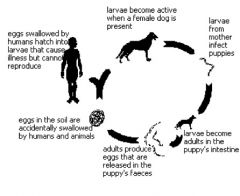![]()
![]()
![]()
Use LEFT and RIGHT arrow keys to navigate between flashcards;
Use UP and DOWN arrow keys to flip the card;
H to show hint;
A reads text to speech;
10 Cards in this Set
- Front
- Back
|
What are obligate vs facultative parasites?
|
An obligate parasite is a parasite that must be with its host, or it dies. Obligate parasites depend on the presence of a host to complete their life cycle. Obligate parasites are common. There are parasitic plants, fungi, bacteria, and animals. The inverse of an obligate parasite is a facultative parasite, a parasite that can complete its life cycle independent of a host.
|
|
|
What are accidental or incidental parasites?
What is an example of one? |

A host in which the parasite is not commonly found,
nevertheless it is one suitable for the parasite's development. In some instances (e.g. cysticercosis) the accidental host becomes a "dead end" because even though the parasite develops through its appropriate stages, it fails to find a portal of exit and is thus blocked from continuing its life cycle. He calls them dead end hosts. Ex: Cercarial dermatitis: swimmer's itch. Or Toxocara canis (in picture) - in humans can cause visceral and ocular larval migran - may cause blindness. |
|
|
What are aberrant hosts?
|
One in which the parasite cannot complete its development or appropriate phase of its development. A dead end host form which it cannot continue its life cycle.
Can be called accidental hosts. |
|
|
What is a definitive parasite host?
NEED TO KNOW |
A host in which the parasite undergoes sexual reproduction. Fertilization occurs within the definitive host.
|
|
|
What is an intermediate parasite host?
NEED TO KNOW |
some development occurs, but parasite does not reach sexual maturity. However, may not always be required to complete life cycle.
One that alternates with the definitive host and harbors the larval stage(s) of the parasite. (Man is the Accidental, Intermediate host of Taenia solium and pigs are the typical intermediate host. ) |
|
|
What is the type of host to parasites that includes no development, but is used to transport the parasite?
NEED TO KNOW What are some examples of them? |

Paratenic (transport) host
e.g., acanthocephalans – insects – shrews – owls. Anisakis – invertebrates, fish, marine mammals An atypical (substitute) intermediate host that ingested and harbors the stage infective for the definitive host, which remains active and unchanged (a collector or storage host). If a suitable definitive host ingests the paratenic host or a part of it containing the infective stage, the parasite can grow to maturity. If man becomes infected, he becomes a substitute but aberrant intermediate host. Examples are third stage juveniles of the nematodes, Physoloptera spp. And Gnathostoma spp and the pleurocercoid (sparganum) stage of certain pseduophyllidian tapeworms. The paratenic host may make the parasite available to atypical definitive hosts that would not normally ingest the typical intermediate host. |
|
|
What is the difference between direct and indirect parasite?
What are examples of each? |
Direct (monoxenous) - A single generation constituting a complete life cycle. Eg: Fleas, SOME ticks, Lice, trichomonads, Giardia, coccidia
In many parasitic groups the whole development is restricted to the tissues of one host individual. The species may be strictly host specific (using only a single host species) or not (e.g. Eimeria, Coccidia). indirect parasite (heteroxenous) - These have required intermediate hosts to complete life cycle. Eg: Digenea (Flukes), Cestodes (Tapeworms), some ticks Requiring more than one host to complete a life. |
|
|
What is a reservoir host?
What is an example of one? |
“An animal species which carries a pathogen, usually without significant detriment to itself, and serves as a source of infection”
E.g., Trichinella in rats: Reservoir for pigs |
|
|
What is "A state of resistance to infection which is established after an acute infection has become chronic and which last while the organism is present"?
|
premunition
|
|
|
What are the three types of developmental styles in terms of production of young?
|
Oviparous – eggs laid unembryonated (e.g. Acaris, Trichuris) or as blastomeres (e.g. hookworms)
Ovoviviparous – eggs laid containing a fully developed embryo - L1 (e.g. Metastrongylus) can hatch while exiting the host and be found in faeces as larvae Viviparous – a fully developed L1 stage larva is discharged from the uterus (e.g. Trichinella) |

